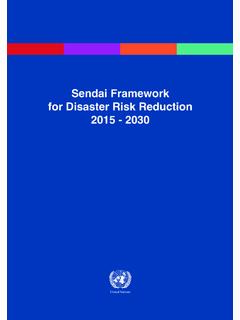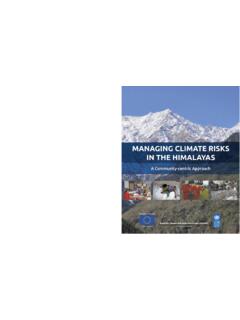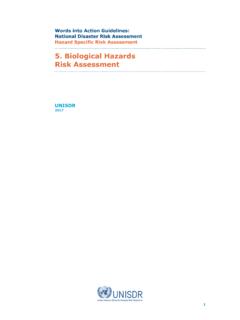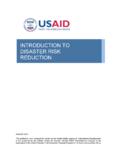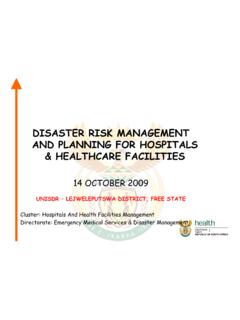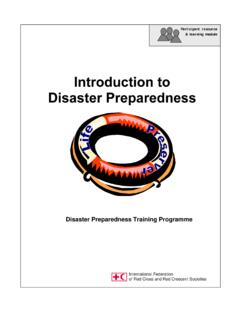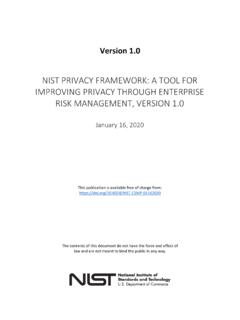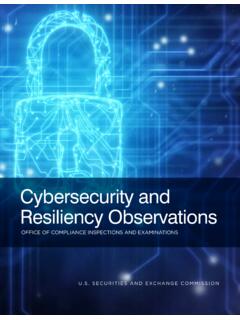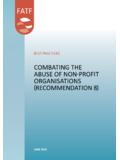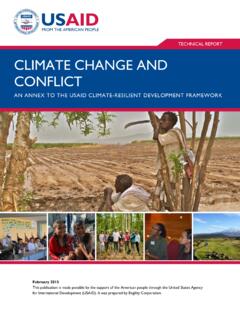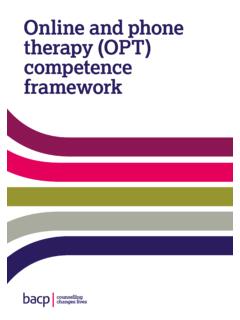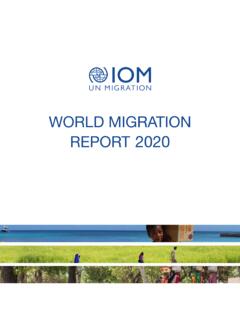Transcription of At Risk: natural hazards, people’s vulnerability and disasters
1 At Risk: natural hazards, people s vulnerability and disasters Second edition 2003 Copyright Wisner, Blaikie, Cannon and Davis The attached three chapters constitute Part I of the book, and have been made available in the public domain by the authors and Routledge as part of the UNDP follow up to the Hyogo Framework for Action 2005. Royalties for the print versions of the book are donated to three disaster reduction networks in the South: La Red (Latin America), Duryog Nivaran (South Asia) and Peri-Peri (Southern Africa) Contents Foreword Preface to new edition Preface to 1994 edition List of figures and tables Part I Framework and theory 1 THE CHALLENGE OF disasters AND OUR APPROACH In at the deep end Conventional views of disaster What is vulnerability ? The basic idea and some variations Risk society?
2 Deconstruction approaches vulnerability and normal/daily life Changes since the first edition The International Decade for natural Disaster Reduction Urban growth and the growth of urban concerns Changes in earth care The emergence of the Precautionary Principle Critiques of economic globalisation Changes in human development and well-being War and humanitarian relief Media and policy selectivity Convergence and critique Convergence Critique Audiences Scope and plan of the book Limits and assumptions Limitations of scale Technological hazards TEXT BOX Naturalness versus the social causation of disasters 2 THE DISASTER PRESSURE AND RELEASE MODEL The nature of vulnerability Two models Cause and effects in the disaster pressure model The chain of explanation Time and the chain of explanation Limits to our knowledge Global trends and dynamic pressures Population change Urbanisation War as a dynamic pressure Global economic pressures Adverse agrarian trends and livelihood diversification natural resource degradation Global environmental change Uses of the Pressure and Release model TEXT BOXES Landless squatters in Dhaka Karakoram and house collapse Problems with disaster statistics Age structure and vulnerabilities 3 ACCESS TO RESOURCES AND COPING IN ADVESITY Access to resources an introduction The purpose of the Access Model Access in more detail New thinking since 1994 Normal life the formal Access model Households and access in a political economy Transitions from normal life to disaster Time-space positioning of hazards Time and
3 disasters Post-event transition to disaster Access, transition and safety Coping and access to safety Coping defined Types of coping strategy Coping and vulnerability analysis Coping and transition to disaster The Access Model as a research framework Part II vulnerability and hazard types 4 FAMINE AND natural HAZARDS Introduction Famines and their causes Explanations of famine Neo-Malthusian explanations Environmental supply-side explanations Economic theories of famine Complex emergencies, policy famines and human rights Causes, pressures, unsafe conditions and famine Access and famines Policy Early Warning Systems Strengthening livelihood systems Response to famine from the grass roots Conclusion TEXT BOX Famine in Malawi 2002 5 BIOLOGICAL HAZARDS Introduction Human health, daily life and vulnerability What are biological hazards?
4 Limitations to our treatment of biological hazards Biological links with other hazards Livelihoods, resources and disasters The role of access vulnerability -creating processes The micro-environment Migration and biological hazards Regional physical environment Pressures affecting defences against biological hazards Genetic defences Environmental and cultural defences Root causes and pressures Biological hazards in Africa Steps toward risk reduction Policy directions Precautionary science TEXT BOXES The Irish Potato Famine (1845-48) AIDS in Africa 6 FLOODS Introduction Flood disasters , challenges and changes in thinking Floods as known risks The paradox of flood control natural dams Flash floods and landslides Disastrous outcomes for vulnerable people Mortality, morbidity and injury Livelihood disruption Floods and vulnerability Summary: flood prevention and mitigation Local-level mitigation social protection and flood precautions Flood mitigation and preparedness TEXT BOXES Floods in China 1998 Small floods: a hidden problem Bangladesh reducing vulnerability to floods is not the same as stopping floods Flooding and deforestation.
5 The causation controversy 7 COASTAL STORMS Introduction The physical hazard Patterns of vulnerability Contemporary coastal settlements and the cyclone hazard Coastal livelihoods Case studies Less-densely populated coasts Rural hinterlands Densely populated coasts Islands and small island states Policy responses 8 EARTHQUAKES AND VOLCANOES Introduction Determinants of vulnerability to earthquakes Access to resources in normal life and transition to disaster Classic case studies: Guatemala and Mexico The Guatemala earthquake, 1976 The Mexico City earthquake 1985 Recent case studies Kobe earthquake 1995 social vulnerability and high-risk groups Unsafe dwellings Economic vulnerability The failure of disaster preparedness measures Community resilience Gujarat earthquake 2001 social vulnerability high-risk groups Unsafe buildings Economic vulnerability Community resilience Volcanoes and related hazards Nevado del Ruiz eruption, Colombia 1985 Montserrat volcanic eruptions, 1995 98 Geography and vulnerability social vulnerability and high-risk groups Unsafe conditions Economic vulnerability Failure of protection measures Livelihoods, warnings, governance and volcanoes Goma, Congo.
6 Eruption of Mount Nyiragongo 2002 social vulnerability and high-risk groups Unsafe conditions Economic vulnerability Failure of protective measures Community resilience Policy response and mitigation TEXT BOXES Progression of vulnerability : Kobe earthquake Progression of vulnerability : Gujarat Earthquake Chronology of events during the Montserrat eruption Progression of vulnerability : Montserrat eruptions Part III Towards a safer environment 9 Towards a safer environment Towards a safer environment: are statements of intent merely hot air? From Yokohama to Johannesburg via Geneva The Yokohama Conference 1994 The IDNDR Programme Forum 1999 The Millennium Declaration 2000 The Johannesburg Summit 2002 Risk Reduction Objectives First Risk Reduction Objective: Understand and communicate the nature of hazards and vulnerabilities and capacities Second Risk Reduction Objective: Conduct risk assessment by analysing hazards, vulnerabilities and capacities Third Risk Reduction Objective: Reduce risks by addressing root causes, dynamic pressures and unsafe conditions Fourth Risk Reduction Objective: Build risk reduction into sustainable development Fifth Risk Reduction Objective: Reduce risks by improving livelihood opportunities Sixth Risk Reduction Objective: Build risk reduction into disaster recovery Seventh Risk Reduction Objective.
7 Build a safety culture TEXT BOXES Emergency Management Australia: Extract from Study on the assessment of personal and community resilience and vulnerability Central America: implementing comprehensive recovery? Flood recovery in Anhui province China, 1993 Bibliography Part IFRAMEWORK ANDTHEORYIn at the deep endDisasters, especially those that seem principally to be caused by naturalhazards, are not the greatest threat to humanity. Despite the lethal reputa-tion of earthquakes, epidemics and famine, a much greater proportion ofthe world s population find their lives shortened by events that often gounnoticed: violent conflict, illnesses, and hunger events that pass for normalexistence in many parts of the world, especially (but not only) in less devel-oped countries (LDCs).
8 1 Occasionally earthquakes have killed hundreds ofthousands, and very occasionally floods, famines or epidemics have takenmillions of lives at a time. But to focus on these (in the understandablyhumanitarian way that outsiders do in response to such tragedies) is toignore the millions who are not killed in such events, but who neverthelessface grave risks. Many more lives are lost in violent conflict and to thepreventable outcome of disease and hunger (see Tables and ).2 Such isthe daily and unexceptional tragedy of those whose deaths are through natural causes, but who, under different economic and political circum-stances, should have lived longer and enjoyed a better quality of Hazard types and their contribution to deaths, 1900 1999 Hazard type in rank order Percentage of deaths Slow onset: Famines drought Rapid onset: Floods Earthquakes and tsunami Storms Volcanic eruptions Landslides Avalanches Negligible Wildfires Negligible Source: CRED at 1 THE CHALLENGE OFDISASTERS ANDOUR APPROACHH owever, we feel this book is justified, despite this rather artificial separa-tion between people at risk from natural hazards and the many dangersinherent in normal life.
9 Analysing disasters themselves also allows us toshow why they should notbe segregated from everyday living, and to showhow the risks involved in disasters must be connected with the vulnerabilitycreated for many people through their normal existence. It seeks the connec-tions between the risks people face and the reasons for their vulnerabilitytohazards. It is therefore trying to show how disasters can be perceived withinthe broader patterns of society, and indeed how analysing them in this waymay provide a much more fruitful way of building policies, that can help toreduce disasters and mitigate hazards, while at the same time improvingliving standards and opportunities more crucial point about understanding why disasters happen is that it isnot only natural events that cause them.
10 They are also the product of social ,political and economic environments (as distinct from the natural environ-ment), because of the way these structure the lives of different groups ofpeople (see Box ).4 There is a danger in treating disasters as somethingpeculiar, as events that deserve their own special focus. It is to risk sepa-rating natural disasters from the social frameworks that influence howhazards affect people, thereby putting too much emphasis on the naturalhazards themselves, and not nearly enough on the surrounding social AND THEORY4 Table Deaths during disasters , listed by cause, 1900 1999 Cause of death [a] Numbers killed (millions) Percentage of deaths Political violence Slow-onset disaster [b] Rapid-onset disaster Epidemics Road, rail, air and industrial accidents TOTAL 100 Notes: athe source for political violence data is Sivard (2001).
